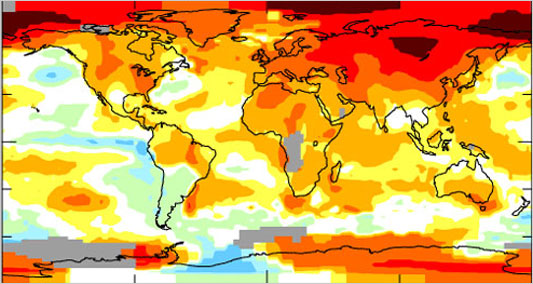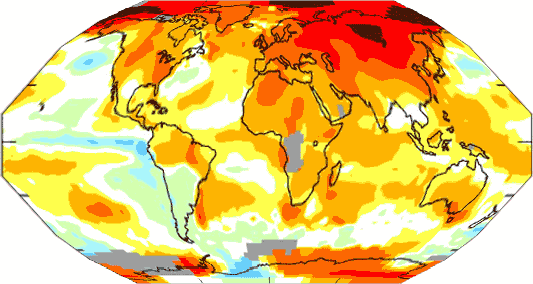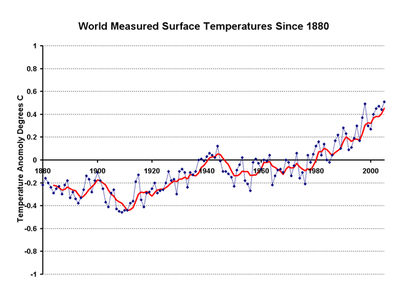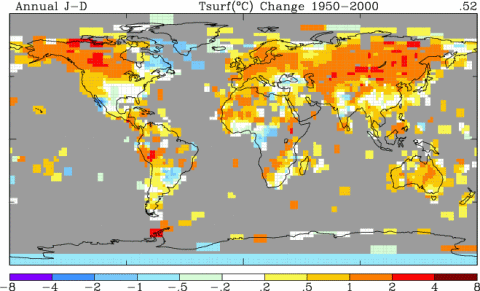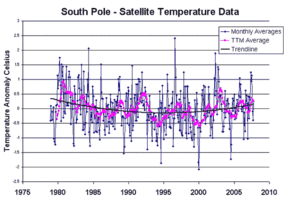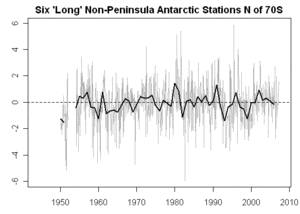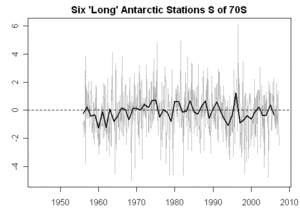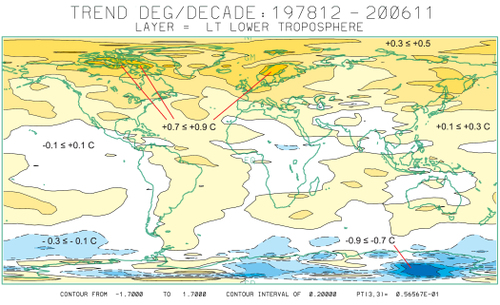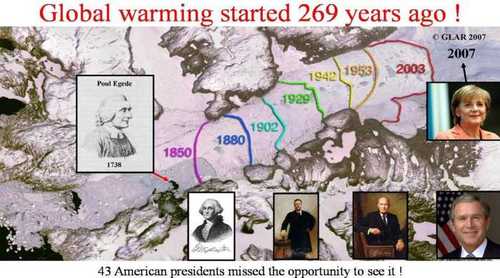I’ve added a lot of updated information to my analysis of the GISS world temperature chart, including a really damning view of what data the GISS actually has to demonstrate the amount of fanciful extrapolation that is going on. See here.
Monthly Archives: January 2008
Chartmanship — A Picture that Sparked A Thousand Words (of Criticism)
Note this chart used by Andrew Revkin:
The description of the chart is as follows:
Map shows areas in 2007 that were warmer (reds) and colder (blues) than the mean annual temperature from 1951-1980. (Credit: NASA/GISS)
It is said that a picture is worth a thousand words. Let me see if I can come up with a thousand words as to what is wrong with this picture.
-
Every school kid knows that this sort of projection of the world greatly exaggerates the size of the poles and Greenland. Since most of the red here is at the poles, then visually its impact is exaggerated. For example, the top row of pixels at the top which constitute a fair percentage of the map actually represent a tiny plot of land at the pole. That row of pixels represents an area at least 10x smaller than does the row of pixels at the equator. I don’t have with me at work a good graphical tool to apply a spherical transform to the map, so I approximated it with a couple of linear skews. This would be a more realistic map, except it still exaggerates the area at the pole (see here to confirm it is a decent approximation)
Flip your eyes between the two of them — already we see a huge visual difference in impression. (Update: better version here, using a tool from the GISS no less!)
- The coloring in and of itself makes a point. The whole world has warmed a half degree or less in this period, but the dark red makes it look sizzling
- Here is the next trick — if you want to make a strong impression of growth, make sure to find the low point in the historical record and compare to that. So, lets look at history:
Hey, what do you know? 1950 to 1980 represents a low point in the trend. Since they were trying to make a point about warming accelerating, then it might have made more sense to look at the warming since, say, 1998 — ie over the last decade. Unfortunately, that chart would be all blue, since temperatures throughout this century have been lower than 1998.
- There are four most frequently cited academic rollups of world-wide temperature anomaly. They are: GISS (surface), HadCrut3 (surface), RSS (satellite) and UAH (satellite). Their current values are all shown here. So, does the NY Times (and other catastrophists) take the average? The median value? No, silly. They take the outlier which shows far more warming than the other three, which is the GISS.
- The GISS surface measurement system is rife with errors. But the one I want to mention here is that, outside of the US, the temperature measurement points are very spotty. Some points in the ocean are over 1000 miles from a thermometer, but still are colored on this chart (yes, there is some grey I suppose for "no data" but that gray should be a lot more prevalent. ) If you only plotted data for 250km squares where the GISS actually has the data do make this comparison, without the mythical extrapolation into unmeasured areas, the chart should look like this:
How did they fill in all that grey area? You tell me because Hansen certainly isn’t talking.
- I am no longer going to accept any climate scientist as a serious scientist (and not just a biased mouthpiece) who insists on using the faulty and patchy surface temperature record over satellite measurement. As I said previously:
Satellite temperature measurement makes immensely more sense – it has full coverage (except for the poles) and is not subject to local biases. Can anyone name one single reason why the scientific community does not use the satellite temps as the standard EXCEPT that the "answer" (ie lower temperature increases) is not the one they want? Consider the parallel example of measurement of arctic ice area. My sense is that before satellites, we got some measurements of arctic ice extent from fixed observation stations and ship reports, but these were spotty and unreliable. Now satellites make this measurement consistent and complete. Would anyone argue to ignore the satellite data for spotty surface observations? No, but this is exactly what the entire climate community seems to do for temperature.
-
Some of the data is just plain bogus on the chart, part of the GISS/Hansen "higher must be right" approach to measuring temperature. The Satellites show Antarctica cooling:
The surface temperature record shows the same thing
There is one area warming – the relatively small Antarctic Peninsula. It should be orange in the map above (and is) but the rest of the orange in Antarctica is a mystery. Though this would not be the first time people tried to extrapolate Antarctic trends from the tip of this peninsula (Gore did it in his movie and 60 minutes did it the other day). This is a bit like measuring US temperature trends from Key West. More on Antarctica here. By the way, the GISS chart without all the extrapolation that I show only has the hot area on the penninsula. All the other hot zones comes from, where? James Hansen’s imagination?
Update: Here is a similar map by satellite, which avoids the coverage issues as well as urban and other surface measurement biases. The story here is much more interesting, particularly the very different experience between north and south, something not predicted by greenhouse gas theory. One can see that there has definitely been warming, but mostly concentrated at the north pole.
Here is the last monthly image, for December, 2007:
Update: I have been getting a lot of new readers of late, including a number of commenters who disagree with me fairly strongly. Welcome. Here are some general thoughts:
- Excepting some ads for Viagra and cell phones, I have never and will never delete a comment on this site. Folks are welcome to fill up the comment threads with contrary opinions. For those distrustful of the motives of skeptics, may I observe that sites like RealClimate cannot make this claim and routinely flush comments that don’t agree with the local prevailing doctrine, so make of that what you will.
- I almost never respond to comments in the comment thread itself. I like to think about and digest the comments for a while, and then incorporate them or respond to them in later posts. Trying to respond in real time in comment threads results in flame wars, not reasoned discussion.
- Unlike many skeptics, I accept that atmospheric CO2 produced by man can warm the earth. The IPCC and most climate scientists believe that the greenhouse gas effect alone may warm the earth about a degree over the rest of this century, an amount that would be a nuisance rather than catastrophic, and likely lost in the random noise of natural variations.
- However, I do not believe the earth’s climate is dominated by strong positive feedbacks and tipping points. It is this feedback hypothesis in climate models that multiplies warming to 3-4-5 degrees or more over the next century. In climate models, the catastrophe comes from feedback, not greenhouse effects, and I think this is a bad hypothesis. Believers in catastrophic warming have an interesting problem reconciling Mann’s hockey stick, which points to incredible stability in temperatures, with a hypothesis of very high positive feedback, which should make temperatures skittish and volatile. I also think that the hypothesis that aerosols are masking substantial amounts of warming is weak, and appears to be more wishful thinking to bail out model builders than solid science (while there is some cooling effect, the area of effect is local and shouldn’t have a substantial effect on global averages).
- I think the surface temperature record as embodied in the GISS analysis is a joke. I cannot respect scientists who eschew obviously superior satellite measurements for the half-assed surface temperature record just because it doesn’t give them the answer they want to here. The fact that the leader in fighting for surface temeprature measurement over satellites is James Hansen of NASA’s Goddard Institute for Space Studies is the ultimate dark irony. It’s like Bill Gates campaiging for increased abacus use in schools.
- I have built models of complex systems for years. I have been guilty many times of allowing seamingly reasonable assumptions to compound into meaningless results. Unfortunately and embarassingly, I have also been guilty of tweaking, plugging, and tuning models to better match history in order to build confidence in their future predictions. I see all too many of these same behaviors amoung climate modellers.
I’m Glad Global Warming Catastrophists Have Science on their Side, Or Else I Might Suspect This Was Ridiculous
A Reuters story a couple of weeks ago said "Carbon Dioxide pollution kills hundreds a Year." Wow. To give one a sense of scale, cold weather kills about 700 people a year in the US alone. So let me see, we want to hamstring the world’s economy and keep hundreds of millions of people in poverty to save fewer people than those who are killed in turn by cold weather?
But the silliness does not end here. This is what the story says:
The deaths were due to lung and heart ailments linked to ozone and polluting particles in the air, which are spurred by carbon dioxide that comes from human activities, according to the study’s author, Mark Jacobson of Stanford University.
As the planet warms due to carbon dioxide emissions, the annual death rate is forecast to climb, with premature deaths in the United States from human-generated carbon dioxide expected to hit 1,000 a year when the global temperature has risen by 1.8 degrees F (1 degree C).
By the way, don’t expect a better explanation of the mechanism of death further in the story, because it is not there, nor should you expect any counter-vailing opinions in this patented Adcocay-press-release-masquerading-as-a-Reuters-story. Here is a big hint for everyone, though: Ozone and some particulate pollution can cause health problems. However, they have nothing to do with CO2 and global warming except that they are coincidently both created by burning fossil fuels. Warmer weather can increase ground ozone levels, but it is absurd to say that this is any kind of substantial mechanism, and nowhere do we see any evidence of how ozone related health problems may scale with temperature. But we can be suspicious because the author is saying deaths go from 700 at 0.8 degrees C increase (which he says is the current level) to 1000 at 1.0 degrees C. So there are 300 more annual deaths just from 0.2C rise? If so, why, when temperatures rise 20C or more in the Phoenix summer, then, aren’t people dropping like flies?
This is just another great example of how incentives work. Funding for academic studies is always hard. A professor who wants to study ozone effect on heath may not get funding. But there is much more available if he pitches it as global warming effect on health, focusing on ozone.
Update to My Best Skeptic’s Argument
Based on a lot of comment activity to this post, I wanted to add a bit of an update. It is sometimes hard to summarize without losing important detail, and I think I had that happen here.
Commenters are correct that positive feedback dominated systems can be stable as long as the feedback percentage is less than 100%. By trying to get too compact in my arguments, I combined a couple of things. First, there are many catastrophists that argue that climate IS in fact dominated by feedback over 100% — anyone who talks of "tipping points" is effectively saying this. The argument about instability making stable processes impossible certainly applies to these folks’ logic. Further, even positive feedback <100% makes a system highly subject to dramatic variations. But Mann et. al. are already on the record saying that without man, global temperatures are unbelievably stable and move in extremely narrow ranges. It is hard to imagine this to be true in a climate system dominated by positive feedback, particularly when it is beset all the time with dramatic perturbations, from volcanoes to the Maunder Minimum.
To some extent, climate catastrophists are in a bind. If historic temperatures show a lot of variance, then a strong argument can be made that a large portion of 20th century warming is natural occilation. If historic temperatures move only in narrow ranges, they have a very difficult time justifying that the climate is dominated by positive feedbacks of 60-80%.
The point to remember, though, is that irregardless of likelihood, the historical temperature record simply does not support assumptions of feedback much larger than zero. Yes, time delays and lags make a small difference, but all one has to do is compare current temperatures to CO2 levels 12-15 years ago to account for this lag and one still gets absolutely no empirical support for large positive feedbacks.
Remember this when someone says that greenhouse gas theory is "Settled." It may or may not be, but the catastrophe does not come directly from greenhouse gasses. Alone, they cause at most nuisance warming. The catastrophe comes from substantial positive feedback (it takes 60-80% levels to get climate sensitivities of 3-5C) which is far from settled science.
Even Shorter Version of Climate Video
After finding out about this contest, I wanted to enter. However, having very little time, I had to work with something I already had on the shelf. So I chose to edit this 9+ minute video critiquing catastrophic global warming forecasts to create a three minute version (per the contest rules).
I am pretty sure this is not what the folks running the contest really are looking for, but I had fun trying. So here is my most edited effort yet, Don’t Panic — The Case Against Catastrophic Global Warming Forecasts.
I had to just assert some things given the time constraints without presenting the evidence (particularly in the aerosol discussion). The more complete 9 minute version critiquing global warming forecasts is here. And the big boy, the 50-minute video covering a wide range of climate change topics, is here.
Taking the World’s Temperature
I have gotten a couple of emails lately from people relatively new to the global warming topic who would just like to find a site that has updates on the earth’s actual temperature and CO2. Unfortunately, that’s not quite as straightfoward as one might expect. Measuring temperature, for example, is quite similar to the old proverb "he who has one clock always knows what time it is; he who has two is never sure."
That being said, this is an excellent summary of temperature and CO2 from several sources, as well as a good overview of how these sources differ. The person who puts the site together is a skeptic but the data sources are the actual data and he is careful to include even those data sources (such as the GISS) that skeptics think are exaggerated.
Land Use and Climate Change
While everyone is running in circles screaming about CO2, Roger Pielke Sr. has done some interesting work on climate change and man’s land use. He has a number of studies discussing how changing land use may have more impact on regional climate than any number of other factors that get more media play. Here is an example of his work.
I Don’t Think it Mattered
A while back, the US Congress decided it was important to be seen as carbon neutral:
As government waste goes, $89,000 will barely register on the meter. However, it did provide a relatively inexpensive demonstration on the costliness of political fads and the vacuousness of carbon-offset markets…
In November, the Democratic-led House spent about $89,000 on so-called carbon offsets. This purchase was supposed to cancel out greenhouse-gas emissions from House buildings…
Some of the money went to farmers in North Dakota, for tilling practices that keep carbon buried in the soil … farmers were already doing this, for other reasons, before the House paid a cent.
Other funds went to Iowa, where a power plant had been temporarily rejiggered to burn more cleanly. But that test project had ended more than a year before the money arrived…
I don’t think Congress cared one bit where the $89,000 was spent. They were spending $89,000 for the tag "carbon neutral" — for the name itself. If the money was [quietly] dumped in a storm sewer or if it the sum had been broken down into $100 bills and used to light the after-dinner cigars at the latest Sierra Club meeting, it wouldn’t matter to Congress one bit. They were buying an $89,000 fig leaf.
How Did Exxon Manage This?
Somehow, man’s burning of fossil fuels in the late 20th century has caused glaciers to begin melting … starting in the 18th century.
Courtesy of I Love My CO2, comes this map of the pretty steady retreat of a glacier in Greenland.
Unfortunately, I can’t find his source. What makes me believe that this is accurate is this similar map of the glaciers at Glacier Bay, Alaska, from Alaska Geographic:
There is also pretty good evidence that the glaciers of Kilamanjaro were retreating before 1900 and most of their measured retreat has occured before 1950. More here.
My Best Skeptic’s Argument
I began with an 85-page book. I shortened that to a 50-minute film, and then a 9-minute film. With that experience, I think I can now pull out and summarize in just a few paragraphs why we should not fear catastrophic global warming. Here goes:
Climate catastrophists often argue that global warming theory is "settled science." And they are right in one respect: We have a pretty good understanding of how CO2 can act as a greenhouse gas and cause the earth to warm. What is well agreed upon, but is not well communicated in the media, is that a doubling of CO2, without other effects that we will discuss in a moment, will heat the earth about 1 degree Celsius (plus or minus a few tenths). This is not some skeptic’s hallucination — this is straight out of the IPCC third and fourth assessments. CO2, acting alone, warms the Earth only slowly, and at this rate we would see less than a degree of warming over the next century, more of a nuisance than a catastrophe.
But some scientists do come up with catastrophic warming forecasts. They do so by assuming that our Earth’s climate is dominated by positive feedbacks that multiply the initial warming from CO2 by a factor of three, four, five or more. This is a key point — the catastrophe does not come from the science of greenhouse gases, but from separate hypotheses that the earth’s climate is dominated by positive feedback. This is why saying that greenhouse gas theory is "settled" is irrelevant to the argument about catastrophic forecasts. Because these positive feedbacks are NOT settled science. In fact, the IPCC admits it does not even know the sign of the most important effect (water vapor), much less its magnitude. They assume that the net effect is positive, but they are on very shaky ground doing so, particularly since having long-term stable systems like climate dominated by positive feedback is a highly improbable.
And, in fact, with the 100 or so years of measurements we have for temperature and CO2, empirical evidence does not support these high positive feedbacks. Even if we assign all the 20th century warming to CO2, which is unlikely, our current warming rates imply close to zero feedback. If there are other causes for measured 20th century warming other than CO2, thereby reducing the warming we blame on CO2, then the last century’s experience implies negative rather than positive feedback in the system. As a result, it should not be surprising that high feedback-driven forecasts from the 1990 IPCC reports have proven to be way too high vs. actual experience (something the IPCC has since admitted).
However, climate scientists are unwilling to back down from the thin branch they have crawled out on. Rather than reduce their feedback assumptions to non-catastrophic levels, they currently hypothesize a second man-made cooling effect that is masking all this feedback-driven warming. They claim now that man-made sulfate aerosols and black carbon are cooling the earth, and when some day these pollutants are reduced, we will see huge catch-up warming. If anything, this cooling effect is even less understood than feedback. What we do know is that, unlike CO2, the effects of these aerosols are short-lived and therefore localized, making it unlikely they are providing sufficient masking to make catastrophic forecasts viable. I go into several reality checks in my videos, but here is a quick one: Nearly all the man-made cooling aerosols are in the northern hemisphere, meaning that most all the cooling effect should be there — but the northern hemisphere has actually exhibited most of the world’s warming over the past 30 years, while the south has hardly warmed at all.
In sum, to believe catastrophic warming forecasts, one has to believe both of the following:
- The climate is dominated by strong positive feedback, despite our experience with other stable systems that says this is unlikely and despite our measurements over the last 100 years that have seen no such feedback levels.
- Substantial warming, of 1C or more, is being masked by aerosols, despite the fact that aerosols really only have strong presence over 5-10% of the globe and despite the fact that the cooler part of the world has been the one without the aerosols.
Here’s what this means: Man will cause, at most, about a degree of warming over the next century. Most of this warming will be concentrated in raising minimum temperatures at night rather than maximum daytime temperatures (this is why, despite some measured average warming, the US has not seen an increase of late in maximum temperature records set). There are many reasons to believe that man’s actual effect will be less than 1 degree, and that whatever effect we do have will be lost in the natural cyclical variations the climate experiences, but we are only just now starting to understand.
To keep this relatively short, I have left out all the numbers and such. To see the graphs and numbers and sources, check out my new climate video, or my longer original video, or download my book for free.
Update: Commenters are correct that positive feedback dominated systems can be stable as long as the feedback percentage is less than 100%. By trying to get too compact in my arguments, I combined a couple of things. First, there are many catastrophists that argue that climate IS in fact dominated by feedback over 100% — anyone who talks of "tipping points" is effectively saying this. The argument about instability making stable processes impossible certainly applies to these folks’ logic. Further, even positive feedback <100% makes a system highly subject to dramatic variations. But Mann et. al. are already on the record saying that without man, global temperatures are unbelievably stable and move in extremely narrow ranges. It is hard to imagine this to be true in a climate system dominated by positive feedback, particularly when it is beset all the time with dramatic perturbations, from volcanoes to the Maunder Minimum.
To some extent, climate catastrophists are in a bind. If historic temperatures show a lot of variance, then a strong argument can be made that a large portion of 20th century warming is natural occilation. If historic temperatures move only in narrow ranges, they have a very difficult time justifying that the climate is dominated by positive feedbacks of 60-80%,
The point to remember, though, is that irregardless of likelihood, the historical temperature record simply does not support assumptions of feedback much larger than zero. Yes, time delays and lags make a small difference, but all one has to do is compare current temperatures to CO2 levels 12-15 years ago to account for this lag and one still gets absolutely no empirical support for large positive feedbacks.
Remember this when someone says that greenhouse gas theory is "Settled." It may or may not be, but the catastrophe does not come directly from greenhouse gasses. Alone, they cause at most nuisance warming. The catastrophe comes from substantial positive feedback (it takes 60-80% levels to get climate sensitivities of 3-5C) which is far from settled science.
Where “Consensus” Comes From
I hate to burst the bubble here, but the American Geophysical Union’s (AGU) climate ‘consensus’ statement does not hold up to even the lightest scrutiny.
It appears that the AGU Board issued a statement on climate change without putting it to a vote of the group’s more than 50,000 members. Its sweeping claims were drafted by what appears to be only nine AGU committee members. The statement relies heavily on long term computer model projections, cherry-picking of data and a very one-sided view of recent research. As with the recent statements by the American Meteorological Society (AMS) and the National Academy of Sciences (NAS), the AGU statement is the product of a small circle of scientists (again apparently a 9 member panel according to AGU) who all share the same point of view, and who failed to put their statement to a vote of the AGU members on whose behalf they now claim to speak. As such it amounts to nothing more than a restatement of the opinion of this small group, not a ‘consensus’ document.
New Climate Short: Don’t Panic — Flaws in Catastrophic Global Warming Forecasts
After releasing my first climate video, which ran over 50 minutes, I had a lot of feedback that I should aim for shorter, more focused videos. This is my first such effort, setting for myself the artificial limit of 10 minutes, which is the YouTube limit on video length.
While the science of how CO2 and other greenhouse gases cause warming is fairly well understood, this core process only results in limited, nuisance levels of global warming. Catastrophic warming forecasts depend on added elements, particularly the assumption that the climate is dominated by strong positive feedbacks, where the science is MUCH weaker. This video explores these issues and explains why most catastrophic warming forecasts are probably greatly exaggerated.
You can also access the YouTube video here, or you can access the same version on Google video here.
If you have the bandwidth, you can download a much higher quality version by right-clicking either of the links below:
- 640 x 480 Windows media version, 86MB
- 320 x 240 Windows media version, 31MB
- Quicktime 640 x 480 version, 245MB
I am not sure why the quicktime version is so porky. In addition, the sound is not great in the quicktime version, so use the windows media wmv files if you can. I will try to reprocess it tonight. All of these files for download are much more readable than the YouTube version (memo to self: use larger font next time!)
This is a companion video to the longer and more comprehensive climate skeptic video "What is Normal — a Critique of Catastrophic Man-Made Global Warming Theory."
Antarctica
On Sunday, CBS claimed that Antarctica is melting. In fact, once small portion of the Antarctic peninsula is warming and may be losing snow, while the rest of Antarctica has not been warming and in fact has been gaining ice cover. The show visits an island off the Antarctic Peninsula which has about as much weather relevance and predictive power to the rest of Antarctica as Key West has to the rest of the United States. Absolutely absurd.
Unfortunately, I have a real job and I don’t have time to restate all the rebuttals to the CBS show. However, I took on the Antarctic issue in depth here, and this post at NC Media Watch has more.
A Metric of Climatge Science Health
If one wanted to measure the "health" of climate science, a good approach would be to compare the zealous pursuit of even the tiniest errors in analyses that show the world to be warming slowly or naturally with the absolute and total apathy at correcting or even uncovering massive errors in anslyses showing substantial man-made warming (example).
Anyone who made this check would have to come to the conclusion that there are not enough skeptical analyses coming into print, rather than the opposite point of view from folks like James Hansen and Al Gore that skeptics are harming the process and need to shut up.
Six Degrees of Global Warming
No, not six degrees of actual temperature increase, but six degrees of separation between every activist’s issue and global warming. As pointed out by Tom Nelson, it should be increasingly obvious to everyone what some of us have been saying for years — the global warming scare is not driven by science, but is a vehicle for pushing a broad range of socialist / progressive issues. Today’s example: Dams on the Klamath River case global warming. The mechanism? Well, its a little hard to grasp because the article is so poorly written (don’t they employ editors on this paper?) but apparently the dams increase algae which in turn off-gasses methane which is a greenhouse gas. Of course, common sense says this effect is trivial, and ignores other effects in the entire system, but the author treats it like he is playing a trump card.
This is Six Inches
There is an old joke that goes "why do women have poor depth perception? A: Because men tell them [holding two fingers very close together] that this is six inches."
I am kind of reminded of that joke here, where the graphic on this eco-catastrophist page shows a 3-foot sea level rise engulfing the botton half of San Francisco’s Transamerica building (hit refresh if you don’t see anyting happening on the top banner). Even the moderately catastrophist IPCC shows less than half of a meter of sea level rise over the next 100 years, not three feet.
By the way, memo to environmental activists: If you want to sway middle America to your cause, complaining that global warming will flood San Francisco may not get the results you want. HT: Tom Nelson
Mother Nature Will Win
In some crazy violation of Boston Globe editorial policy, this article (via TJIC) discusses weather without mentioning global warming. But it does demonstrate how crazy it is to declare that the condition of the Earth circa 1950 was "normal," and any change is somehow abnormal. The article highlights that change itself is the norm.
The sea, some in Chatham say, gives to the town as much as it takes away. The Atlantic constantly erodes the coastline, but also replenishes it with sediment washed from elsewhere. The only problem, says Leo Concannon, Chatham assistant harbormaster, is that the giving and taking "is often not where people want or need it." The region so incessantly reshapes itself with new shoals, sandbars, and breaks that Concannon’s office updates navigational charts with pencils and erasers.
In 2006, the ocean deposited enough sand to reconnect mainland Chatham to South Monomoy Island for the first time in 50 years. In 1987, the change was more abrupt: The Atlantic breached North Beach about 2 miles south of the current break. That gap, now more than a mile wide, eventually destroyed 10 houses on the mainland.
Somehow, the Globe seems to have found the last beachfront homeowner in the country who does not think someone else owes him when nature punishes him for building a house on a sandbar.
Penn on Warming
This is pretty funny
A new menace to the planet has been discovered and validated by a consensus of politically reliable scientists: Anthropogenic Continental Drift (ACD) will result in catastrophic damage and untold suffering, unless immediate indemnity payments from the United Sates, Europe, and Australia be made to the governments of non-industrial nations, to counteract this man-made threat to the world’s habitats….
The continents rest on massive tectonic plates. Until the beginning of the Industrial Revolution in the mid 18th century, these plates were fixed in place and immobile. However, drilling for oil and mining for minerals has cut these plates loose from their primordial moorings and left them to drift aimlessly.
Irony
A few days ago, I wrote about sattelite temperature measurement:
Satellite temperature measurement makes immensely more sense – it has full coverage (except for the poles) and is not subject to local biases. Can anyone name one single reason why the scientific community does not use the satellite temps as the standard EXCEPT that the "answer" (ie lower temperature increases) is not the one they want? Consider the parallel example of measurement of arctic ice area. My sense is that before satellites, we got some measurements of arctic ice extent from fixed observation stations and ship reports, but these were spotty and unreliable. Now satellites make this measurement consistent and complete. Would anyone argue to ignore the satellite data for spotty surface observations? No, but this is exactly what the entire climate community seems to do for temperature.
Today in the Washington Post, Gavin Schmidt of NASA is pushing his GISS numbers that 2007 was really hot — a finding only his numbers support, since every other land and space-based temperature rollup for the earth shows lower numbers than his do. As Tom Nelson points out, the Washington Post goes along with Schmidt in only using numbers from this one, flawed, surface temperature rollup and never mentions the much lower numbers coming from satellites.
But here is the real irony — does anyone else find it hilarious that #1 person trying to defend flawed surface measurement against satellite measurement is the head of the Goddard Institute for Space Studies at NASA?

